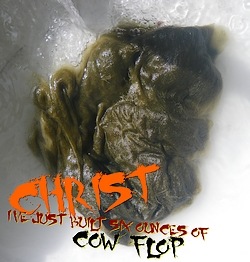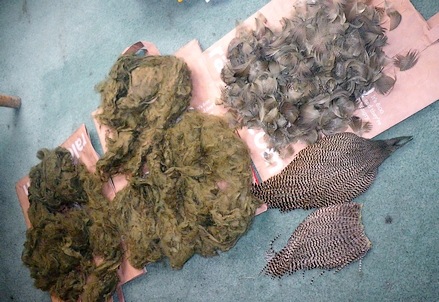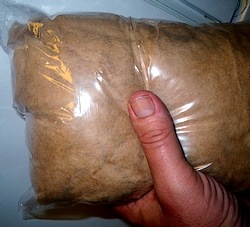There’s no such thing as a bad Olive. Us fly tiers being overly fond of the color and have two dozen shades isn’t half enough. While puzzling my way through the RIT Forest Green – Tan – makes – Olive Conundrum, I’d figures out that it was the dye temperature I’d failed to get hot enough, and only the tan had activated.
Now I was admiring another Olive project, a lot bigger – and I was relieved it wasn’t the unknowns of a balky dye I’d be fighting. I could reproduce the desired color in a single pass through the dye bath, and the target material was fur which is much more friendly than moisture repelling duck feathers.
This time the wrinkle is the material isn’t white, which adds a bit of preplanning when converting one of Mother Nature’s colors into something else.
I’d describe the starting color as a warm tan to a warm light brown, and the qualities of its existing color needed to be factored into our conversion to make it a warm medium Olive.
Olive is Green, Yellow, and a bit of dark Gray or Black. The original color isn’t white – so I’d have to count some of it as the dark component of Olive, and it’s a warm color – so it’ll count as yellow as well.
(From past posts, remember adding green cools the olive, adding yellow warms it, and adding more black – darkens it.)
If we took the same dye formula used on white materials, and we didn’t watch the color closely, merely exposing the material to the bath for the same length of time, we’d wind up with Olive both darker and warmer than our target color. So we’ll remove some of the yellow and some of the black in the dye mixture to compensate.
If medium Olive is 45% Green, 45% Yellow, and 10% Black – I’d compensate with dye bath comprised of 65% Green, 25% Yellow, and 5% black.
 As my starting dye is not a bright green (like Kelly Green), rather it’s a Forest Green, there’ll be no need to add any black, so the final mix will be 75% Forest Green and 25% Golden Yellow (using RIT colors).
As my starting dye is not a bright green (like Kelly Green), rather it’s a Forest Green, there’ll be no need to add any black, so the final mix will be 75% Forest Green and 25% Golden Yellow (using RIT colors).
At right shows the initial rinse, most of the water bleeding off is cold Green which is expected.
Getting your Monies Worth
A single box of RIT will dye a pound of material, and simple tasks like chicken necks or a Hare’s mask will have you pouring most of your money into the sink. A couple ounces of teal feathers or saddle hackle doesn’t even scratch the coloring potential of the full RIT package, and having open dye packages laying around your garage is a known hazard. It’ll sift out of the box or get dropped onto the garage floor in dry form, and the next time the car is washed you’ll track it into the house.
As a fly tyer in the tertiary grip of the obsession, whose materials are purchased by the pound, dyeing represents a way of breathing new life into chewed up material, or making a lifetime supply of questionable colors less so.
I’ll dye the target material and take advantage of the remaining color in the pot to dye other feathers or picked-over Whiting capes – those whose #14, #16, and #18 hackles have already been removed. I’ll use the butt end of the capes for streamers or big dry flies like Green Drakes or Golden Stones.
Having a complimentary shade of Partridge, Guinea Fowl, or that gifted Pheasant your neighbor blew daylight through – lends an extra hide or skin new life, and recoups some of the money you might have paid.
Back to Cow Flop Olive
As I’m already admiring a half pound of cow flop Olive on my carpet, I ran some teal through the dye bath, then followed that with a couple of well chewed Grizzly capes.
Those complimentary colors and dissimilar materials means I’ve got the ability to start tying flies that look cohesive due to color alone. Teal and dubbing is the Bird’s Nest, and dubbing and large Grizzly hackles gives me Green Drakes, Olive Marabou Leeches, and Wooly Buggers.

What most interesting in the picture above is the teal and Grizzly capes. The dye bath was custom built to make a tan into a warm olive, now its true color is revealed to be a cold green. It’s validation of our dye mixture, the tan bleeds through the green to make the fur a warm Olive, and the hackle and teal both started as white/black, and the dye bath builds a colder green absent the warming influence of the tan.
It’s working with Mother Nature’s colors – rather than overpowering them with dye.
… and it’s why you see so many deep dark colors in fly shops and so few pastels. Most commercial vendors use the “overpower” method of dyeing which gut-slams the original color into the background, eliminating the shade it can cast on the final product, and yields dark results.
Working in concert with the original color allows you to build some of the most valuable and sought after colors, like Bronze Blue Dun and the entire Dun family.
The unanswered question is “what am I going to do with half a pound of cow flop Olive?” – mating it with 18 miles of Olive tinsel that I inadvertently purchased is no surprise, but it’s actually a new filler I’m testing – the Poor Man’s Aussie Opossum, only cheaper.
Not to worry, I’ll send samples – once I’ve got the other eight colors dyed.
Tags: dyeing fly tying materials, Olive, colorizing fur, bulk fly tying materials, RIT dyes, teal flank, grizzly hackle, picked over neck, cow flop, fly tying obsession


Hey ‘ole guru of all things from the world of yarn…what yarn are you using…I am haveing some trouble with the last batch I got from Michales sale day.
You mean which yarn am I using to make fur dubbing, or some other use?
The fur dubbing yarn is here.
https://www.iceyarns.com/mohair-angora-knitting-yarns_t9243.html
Postage from Turkey doubles the price, but I can add some additional into my next shipment if you like?
The fur in this article is something entirely new. I haven’t mentioned what it is until I thoroughly test its attributes. I’d rather not send anyone on a wild goose chase for a questionable outcome.
yes I’m in…please let me know when you are ordering.
thanks,
Monty
Have you tried either Dylon or Jacquard dyes? I find them to be more reliable than Rit. They are not as readily available but well worth the effort to find. A useful technique that I have used over the years is over-dying with the brighter colors. Your olive from tan is a good example if you would start from white. You get more subdued and natural coloring than the stark yellow, green, orange, etc you get dying white directly. Maybe we can trade some mongrel colors at some pont. I have dozens of shades of dun to pick from.
@Tworod – I’ve tried Jacquard, but not Dylon. It all depends on the color I’m attempting. RIT makes good pastels (mainly because the dye is not very strong) – and I use the Jacquard and Pro Chemical dyes when I want a rich or vibrant color.
Pro Chemical: https://www.prochemicalanddye.com/store/home.php
Anything bright requires Acid Dyes – and the dull earth tones and pastels I find RIT will work quite nicely.